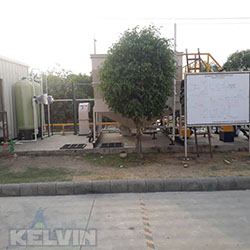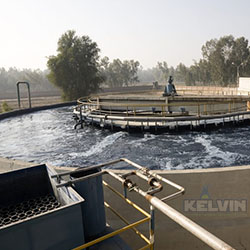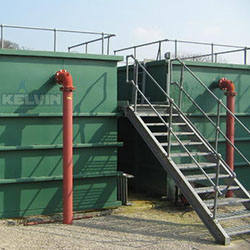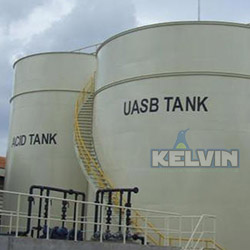
-
Water, Waste Water and Organic Waste
Management Company -

email us
info@kelvinindia.in
-

call us now
+91 9812 24 1001

Activated sludge is a process for treating sewage and industrial wastewater using air and a biological floc composed of bacteria and protozoa. The process involves introduction of air or oxygen into a mixture of primarily treated sewage or industrial wastewater combined with organisms to develop a biological floc which reduces the organic content of the sewage. A Conventional Activated Sludge (CAS) system commonly includes an aeration tank, which is used for biological degradation, and a secondary clarifier (sedimentation tank), where the sludge is separated from the treated wastewater.

In sewage treatment plants, MBBR STP technology employs a moving bed biofilm reactor. The Moving Bed Biofilm Reactor or MBBR process is based on the aerobic biofilm principle and it operates on utilizing the advantages of activated sludge and other biofilm systems without being restrained by their shortcomings. The main theme of this technology is the biofilm carrier elements that are made from polythene or plastic. This element provides a large protected surface area for the biofilm and optimal conditions for the bacteria culture to develop and flourish. MBBR systems don't need a recycling of the sludge, which is the case with activated sludge systems. The MBBR system is often installed as a retrofit of existing activated sludge tanks to increase the capacity of the existing system. The degree of filling of carriers can be adapted to the specific situation and the desired capacity. Thus, an existing treatment plant can increase its capacity without increasing the footprint by constructing new tanks.

One of the cost-effective methods of waste water treatment and sewage management that is primarily used in residential and commercial complexes is Submerged Aerobic Fixed Film Reactor (SAFF). This technology mainly has three stages that are Primary Settlement, Secondary Treatment and Final Settlement / Clarification. Submerged Aerated Fixed Films (SAFF) technology is a process used to reduce the organic loading of residential and commercial sewage / waste water. The process works towards the reduction of Biological Oxygen Demand (BOD) and a significant quantity of Suspended Solids (SS) which if otherwise untreated would contaminate river and other water outlets. In simple words, SAFF process is used to substantially improve effluent discharge quality.

The sequencing batch reactor (SBR) is a fill-and draw activated sludge system for wastewater treatment. In this system, wastewater is added to a single batch reactor, where it is treated to remove undesirable components, and then discharged. Equalization, aeration, and clarification can all be achieved using a single batch reactor. To optimize the performance of the system, two or more batch reactors are used in a predetermined sequence of operations. SBR systems have been successfully used to treat both municipal and industrial wastewater. They are uniquely suited for wastewater treatment applications characterized by low or intermittent flow conditions. SBR reactors treat waste water such as sewage or output from anaerobic digestors or mechanical biological treatment facilities in batches. Oxygen is bubbled through the waste water to reduce biochemical oxygen demand (BOD) and chemical oxygen demand (COD) to make it suitable for discharge into sewers or for use on land and gardens. Sequencing batch reactors (SBR) or sequential batch reactors are industrial processing tanks for the treatment of wastewater.

Membrane bioreactor (MBR) technology has come up as an advanced wastewater treatment technology of choice over the traditional methods such as activated sludge process (ASP), which has been the conventional municipal wastewater technology over the last century. MBR is, in fact, one of the significant innovations in wastewater treatment as it overcomes the drawbacks of the conventional processes, including large space requirement for secondary clarifiers, excess sludge production liquid–solid separation issues and limitations with removal of recalcitrant. While the ASP use a secondary clarifier or settlement tank for solid/liquid separation, an MBR uses a membrane for this function. This provides a number of advantages relating to process control and product water quality. MBRs have been used for municipal as well as industrial wastewater treatment and reclamation. An MBR is a hybrid concept of a conventional biological treatment and physical liquid–solid separation using membrane filtration in a single system.
We are a manufacturer, exporter, supplier, and consultant (also providing installation, commissioning, and consultancy services) of MBR (Membrane Bio Reactor) Sewage Treatment Plants, Plug And Play Packaged MBR STP, and Turnkey Projects based in India.

The up flow anaerobic sludge blanket reactor (UASB) is a single tank process in an anaerobic centralised or decentralised industrial wastewater treatment system achieving high removal of organic pollutants .The Up flow Anaerobic Sludge Blanket reactor (UASB) maintains a high concentration of biomass through formation of highly settleable microbial aggregates. The sewage flows upwards through a layer of sludge. Wastewater enters the reactor from the bottom and flows upward. As the wastewater flows through it, a suspended sludge blanket filters and treats the wastewater. The sludge in the UASB is tested for pH, volatile fatty acids (VFA), alkalinity, COD and SS. If the pH reduces while VFA increases, the sewage should not be allowed into the UASB until the pH and VFA stabilise. Bacteria living in the sludge break down organic matter by anaerobic digestion, changing it into biogas. Solids are also kept intact by a filtration effect of the blanket. The mixing does not require any mechanical assistance in the up-flow regime and due to the motion of the gas bubbles. Bar/Baffles at the top of the reactor let the gases to escape and prevent an outflow of the sludge blanket. The reactor may need to be emptied completely once in five years, while any floating material (scum) accumulated inside the gas collector channels may have to be removed every two years to ensure free flow of gas. As all aerobic treatments, UASB also needs a post-treatment to remove pathogens. However, because of a low removal of nutrients, the effluent water as well as the stabilised sludge can be used in agriculture and other gardening purposes.
Kelvin, a renowned name you can trust on, is the global leader in the manufacturing of STP. Our more than 8 years of waste water treatment expertise and innovation have earned us a world class reputation in the wide range of industries we serve. Want to know more about Sewage Treatment Plant? Explore our website:












Ans. Sewage Treatment Plant (STP) is primarily used to treat residential wastewater collected from houses and other domestic sources to preserve its quality and criteria for safe discharge into surface water and other reuse purposes. STPs are made up of many types of unit activities, the most common of which are sedimentation tanks, aeration tanks, clarifiers, and filters.
Ans. Sewage treatment is the process of eliminating toxins, microorganisms, and other types of pollutants from flowing wastewater. The primary goal of sewage treatment is to create effluent (treated waste water) and solid waste/sludge that can be discharged into the natural environment.
Ans. Below are some commonly used sewages water treatment methods:
Ans. A water treatment plant is a facility where raw water, such as surface water or ground water, is purified for public use. The goal is to create some kind of standard for the water we consume. Raw water does not have it. As a result, purify it in a water treatment plant. On the other side, a sewage treatment plant is a facility where wastewater from households is processed. Wastewater can pollute lakes, rivers, and land. So, we cure them and let it go.
Ans. The following are the top five primary advantages of a sewage treatment plant (STP):














